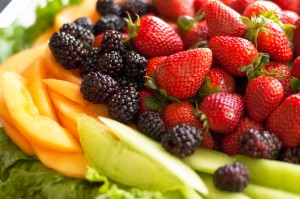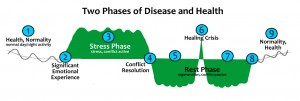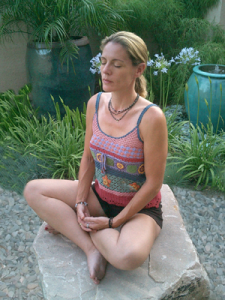I just finished reading this article from Dr. Mercola’s web site. I think you’ll agree that the information is very interesting. As well the tables showing the amount of fructose available in popular fruit is a valuable tool. Here is the article reprinted in its entirety. (or Click here to link to the article.)
 Is this Simple Sugar a Major Factor in the Failure of the War on Cancer? Posted By Dr. Mercola | September 29 2011
Is this Simple Sugar a Major Factor in the Failure of the War on Cancer? Posted By Dr. Mercola | September 29 2011
There’s compelling evidence and agreement by many experts that excessive fructose is toxic to your body. Unlike fructose, nearly every cell in your body can directly use glucose. However fructose is primarily metabolized in your liver and can serve as a substrate for increasing cancer cell growth.
Fructose Helps Cancer Cells Thrive
ALL forms of sugar are detrimental to health in general and promote cancer, but in slightly different ways, and to a different extent, as I’ll explain later. Fructose, however, clearly seems to be one of the most harmful sugars. A new article in Expert Opinion on Therapeutic Targets reviewed the relationship between increased dietary refined sugar and cancer risk, with specific emphasis on the monosaccharide fructose. The researchers noted:
“Recent observations indicate that cancer cells readily utilize fructose to support proliferation and preferentially use fructose for nucleic acid synthesis.”
They named several ways in which dietary fructose can promote cancer growth, including:
- Altered cellular metabolism
- Increased reactive oxygen species (free radicals)
- DNA damage
- Inflammation
Research published in the journal Cancer Research also showed that the way the different sugars are metabolized (using different metabolic pathways) is of MAJOR consequence when it comes to feeding cancer and making it proliferate. According to the authors:
” Importantly, fructose and glucose metabolism are quite different … These findings show that cancer cells can readily metabolize fructose to increase proliferation.”
In this case, the cancer cells used were pancreatic cancer, which is typically regarded as the most deadly and universally rapid-killing form of cancer. The study confirms the old adage that sugar feeds cancer because they found that tumor cells do thrive on sugar (glucose). However, the cells used fructose for cell division, speeding up the growth and spread of the cancer.
Why is This a MAJOR Threat to Public Health?
Whether you’re simply interested in preventing cancer, or have cancer and want to live longer, you ignore these facts and listen to industry propaganda that fructose is safe and no different from other common sweeteners at your own risk. The truth of the matter is that fructose may very well be the most pernicious influence in the Standard American Diet, and is virtually guaranteed to cause chronic disease if consumed in excess.
The major problem is, the vast majority of Americans are consuming fructose at levels 3-600% of the upper limit!
Further, most people are seriously confused about fructose and still believe it is a “healthy” type of sugar because it is found naturally in fruits and touted as having a low glycemic index. But this is not a matter of eating an apple or a handful of raisins as a snack. Fructose, in one form or another, can be found in five of the 10 top sources of calories in America, and in some cases (particularly when processed or from a restaurant) may actually be in ALL of them:
- Grain-based desserts (cakes, cookies, donuts, pies, crisps, cobblers, and granola bars) 139 calories a day
- Yeast breads, 129 calories a day
- Chicken and chicken-mixed dishes, 121 calories a day
- Soda, energy drinks, and sports drinks, 114 calories a day
- Pizza, 98 calories a day
- Alcoholic beverages
- Pasta and pasta dishes
- Mexican mixed dishes
- Beef and beef-mixed dishes
- Dairy desserts
If you’re interested in preventing cancer, my recommendation is to keep your total fructose intake below 25 grams of fructose per day, if you’re in good health. Most people will also benefit from limiting your fructose from fruit to 15 grams a day, and, if you need to lose weight, you likely will need to limit your total fructose consumption to 15 grams a day total, including that from fruit.
If you have cancer, however, you’ll want to reduce your total fructose consumption to below 10 grams per day from all sources, including fruit.
Fruit Serving Size Grams of Fructose
Limes 1 medium 0
Lemons 1 medium 0.6
Cranberries 1 cup 0.7
Passion fruit 1 medium 0.9
Prune 1 medium 1.2
Apricot 1 medium 1.3
Guava 2 medium 2.2
Date (Deglet Noor style) 1 medium 2.6
Cantaloupe 1/8 of med. melon 2.8
Raspberries 1 cup 3.0
Clementine 1 medium 3.4
Kiwifruit 1 medium 3.4
Blackberries 1 cup 3.5
Star fruit 1 medium 3.6
Cherries, sweet 10 3.8
Strawberries 1 cup 3.8
Cherries, sour 1 cup 4.0
Pineapple 1 slice
(3.5″ x .75″) 4.0
Grapefruit, pink or red 1/2 medium 4.3
Fruit Serving Size Grams of Fructose
Boysenberries 1 cup 4.6
Tangerine/mandarin orange 1 medium 4.8
Nectarine 1 medium 5.4
Peach 1 medium 5.9
Orange (navel) 1 medium 6.1
Papaya 1/2 medium 6.3
Honeydew 1/8 of med. melon 6.7
Banana 1 medium 7.1
Blueberries 1 cup 7.4
Date (Medjool) 1 medium 7.7
Apple (composite) 1 medium 9.5
Persimmon 1 medium 10.6
Watermelon 1/16 med. melon 11.3
Pear 1 medium 11.8
Raisins 1/4 cup 12.3
Grapes, seedless (green or red) 1 cup 12.4
Mango 1/2 medium 16.2
Apricots, dried 1 cup 16.4
Figs, dried 1 cup 23.0
What Makes Sugar so Appealing to Cancer Cells?
In 1931 the Nobel Prize was awarded to German researcher Dr. Otto Warburg, who first discovered that cancer cells have a fundamentally different energy metabolism compared to healthy cells. Malignant tumors tend to use a process where glucose is used as a fuel by the cancer cells, creating lactic acid as a byproduct. The large amount of lactic acid produced by this fermentation of glucose from cancer cells is then transported to your liver.
This conversion of glucose to lactic acid generates a lower, more acidic pH in cancerous tissues as well as overall physical fatigue from lactic acid buildup.
This is a very inefficient pathway for energy metabolism, which extracts only about 5 percent of the available energy in your food supply. In simplistic terms, the cancer is “wasting” energy, which leads you to become both tired and undernourished, and as the vicious cycle continues, will lead to the body wasting so many cancer patients experience.
Additionally, carbohydrates from glucose and sucrose significantly decreases the capacity of neutrophils to do their job. Neutrophils are a type of white blood cell that help cells to envelop and destroy invaders, such as cancer. Meanwhile, fructose appears to be preferred by cancer cells for cell division, which contributes to its growth and spreading throughout your body. Even though the theory that sugar feeds cancer was born nearly 80 years ago, most conventional cancer programs STILL do not adequately address diet and the need to avoid sugars and fructose if you have cancer.
As Patrick Quillin, PHD, RD, CNS wrote more than a decade ago:
“During the last 10 years I have worked with more than 500 cancer patients as director of nutrition for Cancer Treatment Centers of America in Tulsa, Okla. It puzzles me why the simple concept “sugar feeds cancer” can be so dramatically overlooked as part of a comprehensive cancer treatment plan. Of the million[s of] cancer patients being treated in America today, hardly any are offered any scientifically guided nutrition therapy beyond being told to “just eat good foods.” Most patients I work with arrive with a complete lack of nutritional advice.”
Artificial Sweeteners are NOT a Safe Sugar Alternative
You may be tempted to swap sugar for artificial sweeteners, but these can damage your health even more quickly than fructose. In fact, there are already hundreds of published studies linking artificial sweeteners like aspartame, which is widely used in diet soda and many other diet foods, to serious health complications. Cori Brackett’s documentary film Sweet Misery is an excellent summary of the problems with aspartame.
You can also view my interview with Victoria Innes-Brown, who over a 2.5-year period performed a set of meticulous and detailed experiments, documenting the effects of using aspartame liquid comparable to diet soda on mice. This included not only large tumors but also neurological effects, paralysis, skin disorders and symptoms of cerebral palsy.
Recent research has also linked diet soda consumption to higher rates of strokes, heart attacks and other lethal vascular events as well as metabolic syndrome.
There is literally enough evidence showing the dangers of consuming artificial sweeteners to fill an entire book — which is exactly why I wrote Sweet Deception. If you or your loved ones drink diet beverages or eat sugar free foods, this book will explain how you’ve been deceived about the truth behind artificial sweeteners like aspartame and sucralose.
For times when you want to add a bit of sweetness to your food or beverages, try using the herb stevia instead. It’s a safe, natural plant that’s has been around for over 1,500 years and is ideal if you’re watching your weight, or if you’re maintaining your health by avoiding sugar. It is hundreds of times sweeter than sugar and has virtually no calories.
Alternatively, you could use Lo Han or pure glucose (dextrose) as a sweetener. It costs about $1 a pound and does not cause many of the adverse biochemical disasters that fructose does.
It is only 70 percent as sweet as sucrose though, so you’ll end up using a bit more of it for the same amount of sweetness, making it slightly more expensive than sucrose—but still well worth it for your health as it has ZERO grams of fructose. Glucose can be used directly by every cell in your body and as such is far safer than the metabolic poison fructose.
Solid Nutrition is Paramount if You Want to Beat Cancer
You’re probably well aware of the link between the foods you eat and your risk of cancer. But if you’re not then please understand that virtually everything you put into (or onto) your body can either help or hinder your natural healing mechanisms, and thereby influence your risk of cancer and your ability to heal from it.
This is not an “alternative” view at all. Rather, even the conservative American Cancer Society states that one-third of cancer deaths are linked to poor diet, physical inactivity, and carrying excess weight.
However, cancer rates are escalating because modern medicine is in no way, shape or form addressing these underlying causes of most cancers. If ever there was an area in which an ounce of prevention is worth a pound of cure it is cancer. I strongly believe that if you are able to work your way up to the advanced health plan, you will virtually eliminate the risk of most cancers. What is often overlooked, though, is that if you already have cancer it is also crucial that you use nutritious foods to help boost your immune system and heal, and this includes avoiding fructose and other sugars.
The Gerson Research Organization maintains a collection of reports documenting the research behind one nutritional approach, the Gerson Therapy, as well as the role of diet on cancer, and you can hear anecdotes from patients who have improved using this nutritional therapy here.
Many of the success stories include people whose conventional doctors gave no hope for recovery, who were able to overcome their disease against all odds using not toxic cancer drugs but natural fruits and vegetables. The system is not a miracle cure for everyone, and even the Gerson Institute states that “No treatment works for everyone, every time” … but most conventional physicians offer only ONE route for cancer treatment — drugs, radiation and surgery — while ignoring or discounting alternative options such as the power of dietary modifications using healthy foods.
What Else Can You do to Prevent and Fight Cancer?
Along with limiting your intake of sugar and fructose, there are several other things you can do for yourself, right now, not only to prevent cancer, but to make sure you have the best chance of recovery if you do get it. Because cancer is almost wholly a man-made disease, it’s especially important to recognize that you do have power over many factors that could cause you to get cancer. Taking control of your health will put you in a position to make the best health decisions possible if you do get cancer.
Here’s a list to get you started on a cancer prevention plan:
- Radically reduce your sugar consumption. Normalizing your insulin levels is one of the most powerful physical actions you can take to lower your risk of cancer, and in order to do so, cutting sugars and grains out of your diet is a must.Eliminating fructose is one of the most important sugars to initially concentrate on. Again, if you have cancer, you’ll want to reduce that to below 10 grams per day from all sources.
- Optimize your vitamin D levels. There’s overwhelming evidence pointing to the fact that vitamin D deficiency plays a crucial role in cancer development. Researchers within this field have estimated that about 30 percent of cancer deaths might be prevented each year simply by optimizing the vitamin D levels in the general population. On a personal level, you can decrease your risk of cancer by MORE THAN HALF simply by getting optimal sun exposure year-round.Alternatively, you could use a safe tanning bed, or, as a last resort, an oral vitamin D3 supplement. Remember the BEST way to raise your vitamin D level is by sun exposure. If you are being treated for cancer it is likely that higher blood levels—probably around 80-90 ng/ml—would be beneficial. To learn the details on how to use vitamin D therapeutically, please review my previous article, Test Values and Treatment for Vitamin D Deficiency.
- Exercise regularly. There’s compelling evidence indicating that exercise can slash your risk of cancer, primarily by reducing elevated insulin levels and normalizing estrogen. For example, women who exercise regularly can reduce their breast cancer risk by 20 to 30 percent compared to those who are inactive. I prefer to view exercise like a drug that needs to be carefully prescribed and performed at a high enough intensity to achieve its maximum benefit.It’s important to include a large variety of techniques in your exercise routine. Additionally it is likely that integrating exercise with intermittent fasting will greatly catalyze the potential of exercise to reduce your risk of cancer and stimulate widespread healing and rejuvenation.
- Get appropriate amounts of high-quality animal-based omega-3 fats.
- Eat as many vegetables as you are comfortable with. Ideally, they should be fresh and organic. Cruciferous vegetables in particular have been identified as having potent anti-cancer properties. Seriously consider vegetable, not fruit, juicing.
- Use a variety of relaxing tools such as meditation, yoga and social support to manage and relieve emotional stress in your life. Even the CDC states that 85 percent of disease is caused by emotions. It is likely that this factor may be more important than all the other physical ones listed here, so make sure this is addressed.
- Maintain an ideal body weight.
- Get enough high-quality sleep.
- Reduce your exposure to environmental toxins like pesticides, household chemical cleaners, synthetic air fresheners, air pollution, and plastic toxins like BPA.
- Reduce your use of cell phones and other wireless technologies, and implement as many safety strategies as possible if/when you cannot avoid their use.
- Boil, poach or steam your foods, rather than frying or charbroiling them.
- Avoid artificial sweeteners, which are actually worse for your health than sugar, and have been linked to brain tumors.



